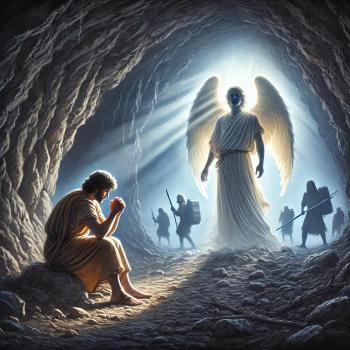Revelation 3:1-6 The Zombie Church
SLIDE 1 and 2
OPENING QUESTION:
Has anyone seen a dead church?
What does it look like?
Does a church look like this?
When people think of dead churches that’s usually what comes to mind. A dead church is usually believed to be:
A small group of believers rattling around in an old building.
Composed of mostly older people in their 70’s and 80’s.
And this group is usually quite content to stay as they are.
SLIDE 3
Experts tell us that churches often go through four stages of life. One person classified them this way:
1. The Movement Stage. This is the beginning stage of most churches. It is a small, intimate and driven group of believers. At this stage the people are nearly 100% committed. They come for Sunday School, Worship, Sunday Evening, Wednesday Night. They spend time together at each other’s homes and in Bible studies.
2. The Magnificence Stage. At this point they’ve reached a high level of attendance. They’ve attained critical mass. Now, because of their size, they can begin to do things they could only dream about before. However, at this point the commitment of the group dips to between 50 and 70%. They still have the vision, and a dream, but the intensity has diminished slightly.
3. The Monument Stage. At this stage, the congregation still does things to increase growth, but they begin to talk less about the future than they do about their past. They’ve reached the point where they work at maintaining their past reputation. They do things because that’s the way they’ve always done them. At this stage, the church is often cursed by power struggles and many talk about the church as “my church” and “our church” as opposed to the “new” people that have only been there for 20 years or less. Commitment level dips to between 10 to 30%.
4. The Mausoleum Stage is the one we would most commonly identify as the “dead church.” People have drifted away or died. Attendance levels are between 10 to 50 on any Sunday, and new people – when they show up – are suspect (they’d take control).
The Mausoleum church is the one we most often identify as the “Dead Church”
But what puzzled me about today’s text is that the church that Jesus calls “dead” (Sardis) has a “reputation of being alive.”
What that indicates to me is that Sardis wouldn’t have been a church you or I would look at and say “that’s one dead church!”
They look alive (even though Jesus declared them to be dead).
Their parking lot may have been full every Sunday, their pews packed to capacity. Their preacher may have been the finest that money could buy. But something had died inside.
I don’t think this church at Sardis had reached the level of a Mausoleum. I suspect Sardis was a church in the “Monument stage.” They appeared to be alive, but as far as Jesus is concerned, they’ had reached a state of being COMATOSE.
And here’s Jesus at their bedside, trying to slap them awake. “Wake up! Wake up!” he tells them.
Things have gotten so serious that Jesus was ready to pull their life support. If they didn’t wake up and change, he would come as a thief in the night and possibly even blot their names out of the book of life.
But Sardis was a church that looked alive!
What happened to them?
More to the point – how can we avoid ending up like them? We don’t want to be a dead church! So, how do avoid their fate?
SLIDE 4 – From Reformation Movement to Reformation Monument (Wycliff, Huss, Luther, Zwingli)
There is a period of church history which is predominantly characterized by Sardis conditions. It extends from the last half of the 16th century, immediately following the Reformation, to about the middle of the 18th century, to the beginning of the Evangelical Awakening. The Reformation, of course, was a time when the church came out of death into life. When Luther discovered the great truth of justification by faith alone and began to preach throughout Germany, the good news spread like wildfire throughout the nations of Northern Europe. People realized afresh the greatness, the liberty of the gospel. All Europe was aflame with freedom. As you watch your television sets today and see the cities of Eastern Europe filled with excited, turned-on people, caught up with the thrill of being set free from conditions of bondage and depression, you are seeing again what must have happened in Europe during the early days of the 16th century. There has not been so much excitement over the toppling of a wall in Berlin since Joshua brought down the walls of Jericho.So also in Luther’s day, the gospel spread like wildfire throughout that area and the cruel walls of spiritual bondage fell before the power of God’s word. The Reformers preached again the truth about Jesus. They preached in the power of the Spirit. Martin Luther in Germany, Count Zwingli in Switzerland, Calvin in Geneva, John Knox in Scotland — all of them preached justification by faith; that Christ was the sufficient Savior of men and they needed to believe that and receive it individually. This good news spread quickly, but it only lasted a relatively short time.
Anyone familiar with church history must wonder at the way the great fires of the Reformation began to cool so quickly after the Reformers had gone. A fatal error had been made. The churches began to fail even while the Reformers were still alive because they neglected large areas of theology and centered upon the way of salvation largely. Thus these men came to make a great and serious mistake. They began to link the oversight and leadership of the church with the government of the country in which they lived! Luther did it when he looked to the German princes for protection against the power of Rome. Zwingli did it in Switzerland because he was associated with the government of the country and brought the churches under his oversight into a direct tie with the state. Calvin did it in Geneva when he sought to turn the city into a theocracy. Knox did it in Scotland as well. The system of State churches was adopted. This practice proved to be a very dangerous and destructive error and it ultimately drained the gospel of its spiritual content. There was no longer life within the great words. The creed was right — and these creeds remain to this day — but in most places where this occurred the vitality of the churches has disappeared.
SLIDE 5 – Reformation Wall in Geneva
SLIDE 6 – Wall of Calvinist Reformers
SLIDE 7 – Luther Monuments
“Ein fester Berg ist Unserer Gott”
“95 Thesis”
“Table Talks” – “Warum rupst und furst du nicht? Hat das nicht gut geschmeckt?”
SLIDE 8 – Prague, CZ – churches that made an impact in changing the world are now museums for visitors to look at and admire. But no one is there to grow relationships with people so that they may see Jesus. Christians come to visit the past, but these churches make no impact on the future.
SLIDE 9 – Examples in Washburn, MO – The old depot in Washburn is not used anymore. The old FBC church is now used for something else. While it serves a good purpose, it is still only a memory.
SLIDE 10 – Today – Washburn FBC – Where are we?
SLIDE 11 – How do we prevent this slide from Movement and Magnificence to Monument and Mausoleum?
When the Lord comes as a thief, if a church is made up of members who are not believers, who have a name to live but have no spiritual life, they will be left behind. Thus our Lord warns here. “If you do not wake up I will come like a thief, and you will not know at what time I will come to you.” As we have said, there are many churches like this today throughout the world. I have been in many of them in different countries, and many also here in the United States. It is sad to see them so lifeless and dull when they could be so alive and vital.
So what do we do about it?
We have to keep investing in people. Buildings are only tools.
We have to look forward more than we look backward. (125th anniversary will be a time when we look backward. But we must also look forward. God did not call us to reach the past. He told us to reach the present and the future.)












